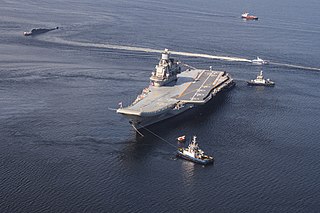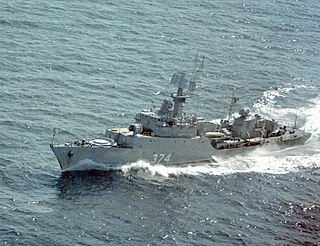
Admiral Flota Sovetskogo Soyuza Kuznetsov is an aircraft carrier serving as the flagship of the Russian Navy. She was built by the Black Sea Shipyard, the sole manufacturer of Soviet aircraft carriers, in Nikolayev within the Ukrainian Soviet Socialist Republic (SSR). The initial name of the ship was Riga; it was launched as Leonid Brezhnev, embarked on sea trials as Tbilisi, and finally named Admiral Flota Sovetskogo Soyuza Kuznetsov after Admiral of the fleet of the Soviet Union Nikolay Gerasimovich Kuznetsov.

The Kuznetsov-class aircraft carrier, Soviet designation Project 11435, is a class of fixed-wing aircraft carriers operated by the Russian and Chinese navies. Originally designed for the Soviet Navy, the Kuznetsov-class ships use a ski-jump to launch high-performance conventional aircraft in a STOBAR configuration. The design represented a major advance in Soviet fleet aviation over the Kiev-class carriers, which could only launch VSTOL aircraft. The Soviet Union's classification for the class was as a heavy aircraft-carrying cruiser, which permits the ships to transit the Turkish Straits without violating the Montreux Convention, however the Chinese variants are classified as aircraft carriers.

The Russian Navy is the naval arm of the Russian Armed Forces. It has existed in various forms since 1696, the present iteration of which was formed in January 1992 when it succeeded the Navy of the Commonwealth of Independent States.

The Grisha class, Soviet designation Project 1124 Albatros, are a series of anti-submarine corvettes built by the Soviet Union between 1970 and 1990 and later by Russia and Ukraine. These ships have a limited range and are largely used only in coastal waters. They have been equipped with a variety of ASW weapons and an SA-N-4 'Gecko' surface-to-air missile launcher. All were fitted with retractable fin stabilizers.

The Echo class were nuclear cruise missile submarines of the Soviet Navy built during the 1960s. Their Soviet designation was Project 659 for the first five vessels, and Project 675 for the following twenty-nine. Their NATO reporting names were Echo I and Echo II. All were decommissioned by 1994.

The Black Sea Fleet is the fleet of the Russian Navy in the Black Sea, the Sea of Azov and the Mediterranean Sea.

The "Kolkata class" (Project 15A) are a class of stealth guided missile destroyers constructed for the Indian Navy. The class comprises three ships – Kolkata, Kochi and Chennai, all of which were built by Mazagon Dock Limited (MDL) in India, and are the largest destroyers to be operated by the Indian Navy. Due to delays in construction and sea trials, the initial commissioning date of the first ship of the class was pushed back from 2010 to 2014.

The Delta class, Soviet designations Project 667B Murena, Project 667BD Murena-M, Project 667BDR Kalmar, Project 667BDRM Delfin, are a series of nuclear-powered ballistic missile submarines, designed and built in the Soviet Union, which formed the backbone of the Soviet and Russian strategic submarine fleet since their introduction in 1973. They carry nuclear ballistic missiles of the R-29 Vysota family, with the Delta I, Delta II, Delta III and Delta IV classes carrying the R-29, R-29D, R-29R and R-29RM respectively. The Delta I class carried 12 missiles, while the Delta II class which are lengthened versions of the Delta I class carry 16 missiles. The Delta III and Delta IV classes carry 16 missiles with multiple warheads and have improved electronics and noise reduction.

Kuznya na Rybalskomu is a ship building and armament company in Kyiv, Ukraine. Although situated on the Dnieper River and presently concentrated on river ships, the company is able to produce & repair small sea vessels, as well as various military equipment.

The Steregushchiy class, Russian designation Project 20380, is the newest class of corvettes being built for the Russian Navy. Designed by the Almaz Central Marine Design Bureau, subsequent vessels were built to an improved design, incorporating the Poliment-Redut SAM system. The ship full displacement and dimensions are large for a corvette, thus it is designated as a frigate by NATO. The Steregushchiy class has been further developed into the Gremyashchiy class and Project 20386 subclasses. The export variant is known as Project 20382 Tigr.

The Nanuchka class, Soviet designation Project 1234 Ovod, are series of corvettes built for the Soviet Navy and export customers between 1969 and 1991.

Lutsk (Луцьк) is an anti-submarine corvette of the Ukrainian Navy. Board number U205. In March 2014 Lutsk was captured by Russian forces during the Crimean crisis.

The Okean Shipyard located in Mykolaiv, Ukraine is the third major ship construction yard in the area. It operates modern production facilities supplied by world known companies and it has a medium and heavy tonnage production line. The yard has constructed many different types of vessels to include non-self propelled barges, sea rescue tugs, timber-carriers, fish-processing factories, bulk carriers, and research ships.

The Admiral Gorshkov class, Russian designation Project 22350 for the original and upgraded version armed with 16 and 24 VLS cells respectively, is the newest class of frigates being built by the Severnaya Verf in Saint Petersburg for the Russian Navy. The Project 22350 was designed by the Severnoye Design Bureau and incorporates use of stealth technology. As of August 2020, ten vessels have been contracted for delivery by 2027. The lead ship of the class, Admiral Gorshkov, was commissioned on 28 July 2018.

The Buyan class,, Russian designations Project 21630 Buyan and Project 21631 Buyan-M, are series of corvettes developed by Zelenodolsk Design Bureau for the Russian Navy. Since 2010, all subsequent vessels are being constructed as improved Project 21631 subclass, incorporating greater tonnage, stealth technology and the 3S14 vertical launching system for either Kalibr or Oniks anti-ship cruise missiles, significantly enhancing combat capabilities. The ships are primarily designed for operations within littoral zones to protect Russia's vast coastal areas. Due to the small tonnage, they can operate even within shallow parts of oceans and seas and Russia's river system. The export variant is known as Project 21632 Tornado.

Black Sea Shipping Company is a Ukrainian shipping company based in Odessa.
Admiral Nakhimov was a Project 1134A Kresta II-class cruiser of the Soviet Navy, named for Russian naval commander Pavel Nakhimov. The third ship of her class, the ship served during the Cold War, from 1971 to 1991. She served with the Northern Fleet for the duration of her career, often operating in the Atlantic and the Mediterranean in order to show the flag. She was decommissioned in 1991 before being sold for scrap due to reduced naval funding in 1993.

Admiral Makarov was a Project 1134A Berkut A class cruiser of the Soviet Navy and briefly of the Russian Navy. The fourth ship of her class, the ship served mostly during the Cold War, from 1972 to 1992. She served with the Northern Fleet for the duration of her career, often operating in the Atlantic and the Mediterranean in order to show the flag, and was refitted between 1983 and 1985. She was decommissioned in 1992 due to deteriorating conditions which reduced naval funding prevented from being addressed before being sold for scrap in 1994.

Marshal Voroshilov was a Project 1134A Berkut A class cruiser of the Soviet Navy, which briefly became part of the Russian Navy after being renamed Khabarovsk in 1991. The fifth ship of her class, the ship served mostly during the Cold War, from 1973 to 1992.



















